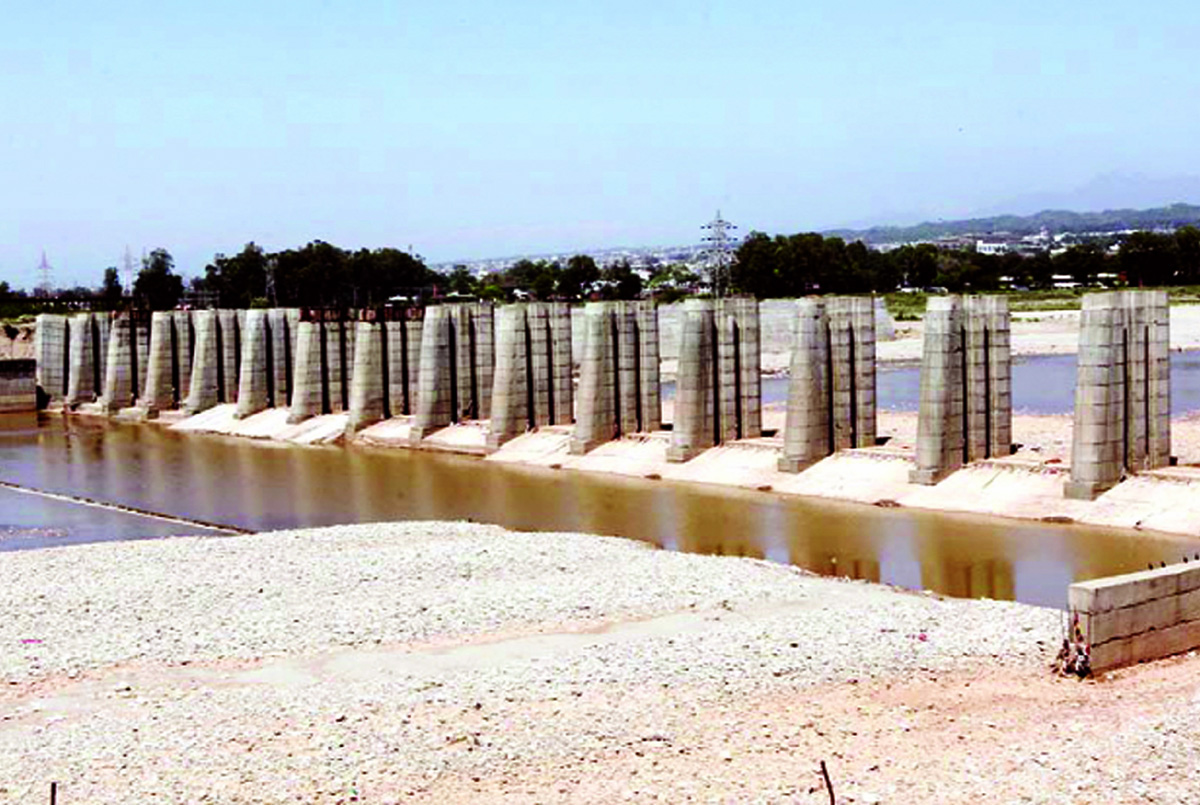Romesh K. Pandita
River Tawi originates from glacier at an elevation of 4250 M (South West of Bhadarwah) in the shape of stream from Kailash Kund, in the Seoj Dhar area of Bhadarwah, District Doda in the Union Territory of J&K. The stream from Seoj Dhar is joined by another stream called Kirchi Stream at Shallu after traversing a distance of about 25 Km and thereafter called as Tawi. The Tawi River in its 141 km long course up to its confluence with river Chenab in Pakistan, traverses through steep slopes along various prominent destination such as Jakhed, Pattan Garh, Mantalai, Chajj, Sudh Mahadev, Binisung, Mandir Daushalla, Chenani Town, Samroli, Laddan Powerhouse, Udhampur, Jaganu, Roun, Krishanpur, Manwal, Jandrah, Athem, Baba Perh, Katal Batal, Nagrota, Jammu City, Nikki Tawi and finally Thub village to join Chenab River.
Some prominent streams that join Tawi River are; stream from Gou Karan above Sudh Mahadev that joins Tawi at Binisung, another stream Raji joins before the start of Chenani Power House and stream starting from Dudar joins at Gudar.
Summer monsoon rainfall starts from beginning of July with heavy thunder showers and continue up to end of September. As a result, Tawi River experiences heavy floods during the months July and August. Upper parts of the catchment are snow fed, while as the lower parts are dominantly rain fed. The summer months are characterised by elevated discharge due to snow melting in the Kalikundi glacier valley, while low discharge is experienced in the month of September, October, November and December. The river has recorded its highest discharge in September 2014 at Jammu.
Tawi Artificial Lake
The construction of Tawi Artificial Lake at Jammu by way of constructing of auto-mechanical barrage on river Tawi, one kilometre downstream of main Tawi Bridge (2nd) and just upstream of Tawi Bridge (4th) near Bhagwati Nagar was launched by the Congress-NC Government in 2010.
The proposal consisted of creating an artificial lake of 1,500-metre length and 600-metre width for impounding of Tawi water right from downstream of Bridge at Gujjar Nagar to the upstream of bridge at Bhagwati Nagar. The artificial lake was considered first of its kind to give a new look to Jammu City and to boost tourism in Jammu province. The construction work on the much hyped project started in 2010 during Government headed by Omar Abdullah. It was stated that, after several tangles the design by Institute of Technology New Delhi, the project was approved by Central Water Commission of India, New Delhi. The project construction work of mechanically operated gated barrage of 370 meter long and 4 meter height was allotted to M/S GVR Infra Ltd. Hyderabad. The Department of Irrigation and Flood Control has been monitoring execution of work.
The completion of project missed its first target date in 2012, followed by several deadlines in 2013, 2015, 2016, 2017 and 2018. It may not be out of place to mention here that the project suffered a major damage in the completed portions of barrage due to floods in Tawi river in August 2016, when a portion of concrete embankment having a length of about 200 feet breached in the middle portion of the barrage and two piers of floodgates (completed already) got tilted, presumably due to undercutting/scouring. One pier had already been damaged/ tilted due to floods in September 2014.
In the initial stage of execution of the project, the then Ministers and the officers in the administration claimed that move to construct the Tawi artificial lake was aimed at giving a new look to the state’s winter capital and boosting tourism in Jammu, as lot of migratory birds will be attracted by the water body. It was also claimed that the presence of the artificial lake will help lower the temperature in the Jammu city during summer months to some extent, help in recharging of underground water and provide irrigation facilities. Contrary to the tall claims and the hype created, the structure has become an eye sore in the Temple City of Jammu. The fate of much touted big ticket tourism projects in the ‘city of temples’, Artificial Tawi Lake Project, is still not clear. Normally a project of this magnitude should have been completed within two to three years due to availability of high technology, machinery and equipment in the current age. An expenditure of about Rs. 60 crores is stated to have been incurred on the construction of the structure; has gone waste and in-fructuous.
Inordinate delay of nearly 8 years in completion of the much touted project is bound to raise several apprehensions in the minds of general public in Jammu. There is a feeling in the general public that the project was started in a hush-hush manner at the instance of some powerful ministers at the helm of affairs without proper model studies regarding behaviour of Tawi River which carries a lot of bed load in the shape of boulders, aggregate, silt and sand. Moreover, Tawi river from By-pass Road Bridge to Bhagwati Nagar Bridge being in the deposition regime due mild gradient of the bed, as compared to its gradient in higher reaches is expected to experience a heavy deposition once the velocity of water reduces due to construction of Barrage. Tilting of the piers after the completion of the structure and breaching of a major portion of embankment is also bound to raise some relevant question mark regarding investigation and structural design of the substructure.
(The author is Ex. GM SASB, Ret.SE, R&B)
Trending Now
E-Paper


